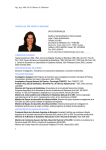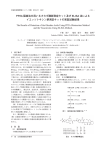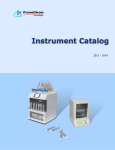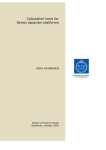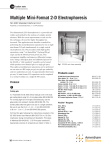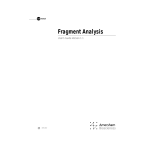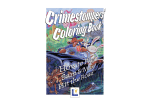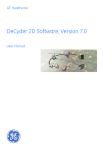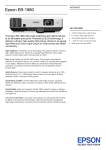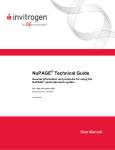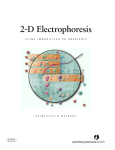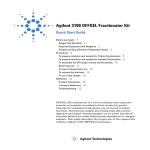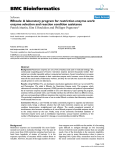Download Two-Dimensional Difference Gel Electrophoresis - PPKE-ITK
Transcript
C H A P T E R 24 Two-Dimensional Difference Gel Electrophoresis: Application for the Analysis of Differential Protein Expression in Multiple Biological Samples John F. Timms Healthcare), with a third dye (Cy2) introduced, allowing simultaneous analysis of three samples on a single gel. In expression profiling experiments, one dye is used to label an internal standard to be run on all gels against pairs of test samples labelled with the other two dyes. This allows the direct comparison of ratios of expression across multiple samples and gels, improving the ability to distinguish biological variation from gel-to-gel variation. Because the labelling strategy employed is compatible with downstream identification of gel spots by mass spectrometry (MS) (Tonge et al., 2001; Gharbi et al., 2002), 2D-DIGE is of particular use as a reproducible, high-throughput proteomic technology. This article describes the necessary materials and instrumentation, experimental design, and work flow for the preparation and labelling of samples for 2D-DIGE analysis. Image capture, analysis, and spot picking for MS identification are also described. I. I N T R O D U C T I O N Fluorescence two-dimensional difference gel electrophoresis (2D-DIGE) is a recently developed 2D gelbased proteomics technique that provides a sensitive, rapid, and quantitative analysis of differential protein expression between biological samples. Developed by Minden and co-workers (Unlu et al., 1997), the technique utilizes charge- and mass-matched chemical derivatives of spectrally distinct fluorescent cyanine dyes (Cy3 and Cy5), which are used to covalently label lysine residues in different samples prior to mixing and separation on the same 2D gel. Resolved, labelled proteins are then detected at appropriate excitation and emission wavelengths using a multiwavelength fluorescence detection device and the signals compared. As well as reducing the number of gels that need to be run, differential labelling and mixing mean that samples are subjected to the same handling procedures and microenvironments during 2D separation, raising the confidence with which protein changes can be detected and quantified. Because fluorescence detection also provides a superior linear dynamic range of detection and sensitivity to other methods (Patton, 2000), this technology is suited to the analysis of biological samples with their large dynamic ranges of protein abundance. The 2D-DIGE methodology is now commercialized as the Ettan DIGE proteomics system (GE Cell Biology II. MATERIALS A N D INSTRUMENTATION The CyDye DIGE fluors N-hydroxysuccinimidyl (NHS) esters of Cy2 (Prod. Code RPK0272), Cy3 (Prod. No. RPK0273), and Cy5 (Prod. No. RPK0275) are from GE Healthcare. NHS-Cy3 and NHS-Cy5 are also synthesized in-house following the original published protocol (Unlu et al., 1997), with modifications 189 Copyright 2006, Elsevier Science (USA). All rights reserved. 190 PROTEINS (unpublished data). Anhydrous 9 9 . 8 % N,Ndimethylformamide (DMF, Cat No. 22,705-6) is from Aldrich, urea (Cat. No. U-0631), dithiothreitol (DTT, Cat. No. D-9163), thiourea (Cat. No. T-8656), and Llysine (Cat. No. L-5626) are from Sigma. 1.5 M Tris solution, pH 8.8 (Prod. No. 20-79000-10), 1 M Tris solution, pH 6.8 (Prod. No. 20-7901-10), and 10x Tris-glycine SDS electrophoresis buffer (Prod. No. 2064) are from Severn Biotech Ltd. Phosphate-buffered saline (PBS, Cat No. 14190-094) is from GIBCO. Nonidet P-40 (NP-40, Prod. No. 56009D2L), bromphenol blue (Prod. No. 200173J), methanol (Prod. No. 10158BG), and glacial acetic acid (Prod. No. 27013BV) are from VWR. 3-[(3-Cholamidopropyl)-dimethylammonio]-l-propanesulfonate (CHAPS, Cat No. B2006) and sodium dodecyl sulphate (SDS, Cat. No. B2008) are from Melford Laboratories Ltd. Coomassie protein assay reagent (Prod. No. 1856210) is from Pierce, S&S weighing papers (Cat. No. Z13411-2) are from Aldrich, and low-gelling temperature agarose (Cat. No. 05075) is from Fluka. Ampholines (pH 3.5-10, Cat. No. 80-1125-87), Pharmalyte (pH 3-10, Cat. No. 17-0456-01), Immobiline DryStrip reswelling tray (Cat. No. 80-6465-32), Immobiline DryStrip IEF gels (IPG strips, Cat. No. 17-600245), Multiphor II electrophoresis unit (Cat. No. 18-1018-06), Ettan DALT low fluorescence glass plates (27 x 22 cm, Cat. No. 80-6475-58), Plus One Repel Silane (Cat. No. 17-1332-01), Plus One Bind Silane (Cat. No. 17-1330-01), reference markers (Cat. No. 18-114334), Ettan DALT 12-gel caster, separation unit, and power supply (Cat. Nos. 80-6467-22 and 80-6466-27), Typhoon 9400 imager (Cat. No. 60-0038-54), Ettan Spot Picker (Cat. No. 18-1145-28), and DeCyder differential analysis software (Cat. No. 56-3202-70) are from GE Healthcare. SYPRO Ruby protein gel stain (Cat. No. S-12000) is from Molecular Probes, and colloidal Coomassie brilliant blue G-250 tablets (CBB, Cat No. K26283182) are from Merck. The Immobilon-P polyvinylidene fluoride transfer membrane (PVDF, Cat. No. IPVH00010) is from Millipore. III. PROCEDURES A. Experimental Design The following steps are guidelines for the design of 2D-DIGE expression profiling experiments. Several experiments are outlined to illustrate how samples can be fluorescently labelled and mixed for 2D gel separation and image analysis so that statistically meaningful data can be acquired. The throughput of the technique is, however, dependent upon the 2D gel running, image capture, and analysis capabilities of the laboratory. We routinely run 12-gel experiments providing accurate differential expression data for 24 samples, including an internal standard run on all gels for accurate spot matching and quantitation. The same gels are then poststained and proteins of interest are picked for MS identification. 2D-DIGE is applicable for the analysis of total cell lysates and complex protein mixtures from cultured cells, whole tissues, sorted or fractionated cells, whole organisms (E. coli, S. pombe, C. elegans, etc.), cellular subfractions (membrane, nuclear, cytoplasmic, etc.), or affinity-purified protein fractions. Steps 1. Three spectrally distinct fluorescent CyDyes (Cy2, Cy3, and Cy5) can be used for differential labelling of protein samples. In the simplest expression profiling experiment, two individual samples are labelled with two different dyes, mixed, and resolved on a single 2D gel (see Section III,B). Because the same protein isoforms in each sample will comigrate, one can accurately measure differential expression as the ratio of the fluorescence intensities of comigrating spots. Thus, the problem of gel-to-gel variation is avoided. This type of single gel experiment is useful where only limited sample quantities are available, e.g., laser capture dissection-procured normal and cancer cells (Zhou et al., 2002). 2. To obtain statistically meaningful expression changes, at least triplicate samples should be labelled and analysed on separate gels. These may be biological replicates, e.g., three separately grown cell cultures or tissue from three individual animals, or may be experimental replicates, where three aliquots of the same sample are compared across different gels. Differential expression can then be taken as an average fold change (e.g., the average spot intensity ratio between differentially labelled spots matching across all three gels) with statistical confidence provided by applying a t test. Of note we have found considerable interanimal variation in liver lysates from mice (unpublished data), and it is therefore advisable to analyse samples from at least five individual animals for each treatment or condition to provide statistically meaningful data. 3. 2D-DIGE analysis is further improved by running a Cy-labelled internal standard on all gels against pairs of test samples, labelled with the other two CyDyes. This increases the ability to distinguish biological variation from gel-to-gel variation by increasing the confidence with which spots can be matched across gels and by allowing the direct comparison of expression ratios across samples. An equal TWO-DIMENSIONAL DIFFERENCEGEL ELECTROPHORESIS pool of all samples (including biological replicates) is best employed as an internal standard as it will contain proteins present in all samples. It is created simply by mixing and labelling equal amounts of protein from every sample and should provide sufficient material for the number of gels to be run. Equal amounts of standard and test samples are then resolved on each gel. 4. In an experiment comparing 100 ~g of protein from cell A and cell B, lysates from triplicate cultures are prepared and protein concentrations determined (six samples). For simplicity, samples are adjusted to the same protein concentration by adding lysis buffer. Then 100 ~g of each is labelled with Cy3 or Cy5 as shown in Table I. A pool consisting of a mixture of 50 ~tg of each of all the replicate samples (300 ~tg total) is labelled with Cy2. Following labelling, the samples are mixed appropriately for separation on three 2D gels as shown in Table I. This scheme controls for dye bias, although labelling combinations are interchangeable so long as each gel is loaded with samples labelled with distinct dyes. This experiment generates nine images for matching, cross-comparison, and statistical analysis in the biological variance analysis (BVA) module of DeCyder software. 5. For complex comparisons we recommend running 12 gels at once. This allows imaging within a day and fits with our downstream laboratory work flow. Although more gels can be run in an individual experiment, consistency may be compromised by running gels at different times or on different electrophoresis units, or may be impractical depending on man power, resources, and automation. Still, it is possible to compare 24 different samples in a single 12-gel 2D-DIGE experiment. For example, our laboratory was able to analyse lysates from two cell lines subjected to growth factor stimulation for four different time periods (8 conditions) using triplicate cultures (Gharbi et al., 2002). The 24 lysates generated were labelled with Cy3 or Cy5 and run in pairs against the internal standard (a pool of all samples) labelled with Cy2. This generated 36 images for DeCyder BVA analysis, with an image acquisition time o f - 8 h using a Typhoon 9400 imager. E x a m p l e of Differential Labelling, Mixing, and Loading for Statistical Comparison of Protein Expression in Two Cell Lines Using 2D-DIGE TABLE I Gel 1 Gel 2 Gel 3 Cy3 Cy5 Cy2 100 ~tg A, replicate 1 100 ~tg B, replicate 2 100 ~tg A, replicate 3 100 ~tg B, replicate 1 100 ~tg A, replicate 2 100 ~tg B, replicate 3 100 ~tg pool 100 ~tg pool 100 ~tg pool 191 B. Preparation of CyDye-Labelled Samples for 2D Electrophoresis The following procedure can be applied for the preparation and labelling of multiple samples for 2DDIGE comparative protein expression analysis. The procedure is based on the Ettan DIGE System (GE Healthcare), with some modifications. The protocol is designed to generate differentially labelled samples that are compatible with all systems for 2D gel electrophoretic separation. The principles and applications of 2D gel electrophoresis are discussed in more detail elsewhere in this volume. For brevity, the sample preparation is outlined for 24-cm pH 3-10 NL-immobilised pH gradient (IPG) gels. Accordingly, final volumes, protein loads, and IPG buffers may differ depending on the size and pH range of the firstdimension gels. Solutions 1. CyDyes (NHS-Cy2,-Cy3,-Cy5): From lyophilized powder (stored at-20~ reconstitute to I mM stock by dissolving in the appropriate volume of anhydrous DMF. Keep stock solutions in the dark at -20~ they are stable for up to 4 months. 2. Lysis buffer: 8 M urea, 2 M thiourea, 4% (w/v) CHAPS, 0.5% NP-40 (w/v), 10 mM Tris-HC1, pH 8.3. To make 100 ml, dissolve 48 g of urea and 15.2 g of thiourea in 50 ml of distilled H 2 0 . Add 4 g CHAPS, 0.5 g NP-40, and 0.67 ml of 1.5 M Tris, pH 8.8, solution. This should give a final pH of 8.3. Make up to final volume, aliquot, and store at-20~ Do not heat. 3. 40% (w/v) CHAPS: To make 50 ml, dissolve 20 g CHAPS in distilled H 2 0 and complete to 50 ml. Store at room temperature. 4. 10% (w/v) NP-40: To make 50 ml, dilute 5 g of 100% NP-40 in distilled H20 and complete to 50 ml. Store at room temperature. 5. L-lysine solution: 10 mM L-lysine in H 2 0 . Dissolve 9.1 mg in 5 ml distilled H20. Aliquot and store at -20~ 6. DTT solution: 1.3 M DTT in H20. To make 10 ml, dissolve 2 g DTT in distilled H20 and complete to 10 ml. Aliquot and store at -20~ Do not heat. 7. Ampholines/Pharmalyte mix: Mix equal volumes of ampholines (pH 3.5-10) and Pharmalyte (pH 3-10). Store at 4~ These broad pH range IPG buffers can be replaced with narrow range buffers depending on the first-dimension pH range. 8. Bromphenol blue: 0.2% (w/v) bromphenol blue in H20. To make 10 ml, weigh 20 mg bromphenol blue and complete to 10 ml with distilled H20. Filter and store at room temperature. 19 2 PROTEINS Steps 1. Wash cultured or fractionated cells, whole organisms, or tissues in PBS or, if possible, a low-salt buffer that does not compromise cellular integrity. Salts should be kept to a minimum so drain well. Subcellular or affinity-purified fractions should be prepared at high protein concentration (>2.5 mg/ml) in a low-salt buffer (<10 mM) or dialysed against a low-salt buffer. 2. Lyse cells in lysis buffer using appropriate physical disruption (sonnication, grinding, homogenisation, repeated passage through a 25-gauge needle). Do not let samples heat up. A volume of buffer should be used to give a final protein concentration of at least I mg/ml. For cellular fractions in a known volume of low-salt buffer and at >2.5 mg/ml, add urea, thiourea, 10% NP-40, 40% CHAPS, and 1.5 M Tris, pH 8.8, solution to give final concentrations of 8 M urea, 2 M thiourea, 4% (w/v) CHAPS, 0.5% (w/v) NP-40, and 10 mM Tris (same as lysis buffer). Rotate on a wheel at room temperature until reagents have dissolved. Because the volume is increased substantially upon reagent addition, amounts should be calculated for 2.5 times the original sample volume. Thus, for a 1-ml sample, add 1.2 g urea, 0.38 g thiourea, 250 ~tl 40% CHAPS, 125 ~tl 10% NP-40, 16.67 ~tl 1.5 M Tris, pH 8.8, and make to 2.5 ml with lysis buffer. Use weighing papers to avoid static during weighing. The final pH should b e - 8 . 3 , the optimum for NHS-CyDye labelling. 3. Determine protein concentrations using Pierce Coomassie protein assay reagent according to the manufacturer's instructions, using BSA in lysis buffer to generate a standard curve. It is recommended that at least four replicate assays are performed for each sample for accurate protein determination. Dilute concentrated samples with lysis buffer if necessary. For ease, samples should be adjusted to the same protein concentration at this point using lysis buffer. 4. Aliquot desired amount of sample into tubes for CyDye labelling. Typically we label 100 ~tg of protein in triplicate using a random combination of Cy3 and Cy5 across the sample set (See Experimental Design). Mix equal amounts of protein from each sample to create an internal standard. This is labelled with Cy2 and should provide enough material for the number of gels to be run (100 ~tg/gel). 5. Label samples by the addition of 4 pmol of the appropriate CyDye per microgram of protein (400 pmol/100 ~tg, equivalent to 4 ~tM for a 1-mg/ml sample). CyDye stocks can be diluted with anhydrous DMF to avoid pipetting submicroliter volumes. Incu- bate samples on ice in the dark for 30 min. Note that protein lysates are viscous so ensure thorough mixing at all steps to avoid non-uniform labelling. 6. Quench reactions by adding a 20-fold molar excess of L-lysine. For 400 pmol CyDye, add 0.8 ~tl of 10 mM L-lysine solution. Incubate on ice in the dark for 10 min. 7. Mix Cy3- and Cy5-1abelled samples appropriately and add a 100-~tg aliquot of the Cy2-1abelled pool (to give 300 ~tg total protein). Note that the final volume should be less than that required for reswelling of IPG strips (450 ~tl for 24-cm strips). This reswelling volume dictates the practical lower limit for sample protein concentrations. 8. Reduce samples by adding 1.3 M DTT to a final concentration of 65 mM (22 ~tl). Add carrier ampholines/Pharmalyte mix to a final concentration of 2% (v/v) (9 ~tl) and 1 ~tl of 0.2% bromphenol blue. Adjust volume to 450 ~tl with lysis buffer. Spin samples briefly. 9. Rehydrate Immobiline DryStrip pH 3-10 NL gels with samples overnight in the dark at room temperature in a reswelling tray according to the manufacturer's instructions (passive rehydration method). Other methods of sample loading (cup loading, rehydration under voltage) can also be applied depending on user preference. 10. Perform 2D electrophoresis following guidelines for the type of system employed, but see Section III,C for recommended modifications. Comments 1. Primary amines and reducing agents should be avoided as they interfere with CyDye labelling. These include carrier ampholines/Pharmalytes and DTT, which are therefore added after labelling but prior to 2D-PAGE. 2. It is often necessary to use protease, kinase, and phosphatase inhibitors for the preparation of lysates and cellular fractions. We have found that aprotinin (17 ~tg/ml), pepstatin A (1 ~tg/ml), leupeptin (1 ~tg/ ml), EDTA (1 mM), okadaic acid (1 ~tM), fenvalerate (5 ~tM), BpVphen (5 WV/), and sodium orthovanadate (2 mM), at the final concentrations shown, do not interfere with CyDye labelling. 3. The quantity of CyDye used for labelling is limiting in the reaction and only N3% of protein molecules are labelled on an average of one lysine residue (minimal labelling). This minimal labelling approach maintains sample solubility and prevents heterogeneous labelling that would lead to vertical spot trains. However, because 436 Da (Cy2), 467 Da (Cy3), or 465 Da (Cy5) is added to the 3% of labelled molecules, a slight shift in migration is observed between TWO-DIMENSIONAL DIFFERENCEGEL ELECTROPHORESIS 193 CyDye and poststained images (Gharbi et al., 2002). This is more noticeable in the lower molecular weight range and necessitates poststaining with a general protein stain to attain accurate picking of the majority (97%) of unlabelled protein (see Section III,D). C. Preparation of 2D Gels, Imaging, and Image Analysis Isoelectric focusing and second-dimension polyacrylamide gel electrophoresis of CyDye-labelled samples can be performed on any system following the manufacturer's instructions. However, inclusion of the following steps is recommended for high sensitivity, reproducibility, accuracy in the determination of differential expression, and precise excision of protein features for MS identification. The steps are detailed for use with the Multiphor II IEF and Ettan DALT 12 PAGE separation systems for 24 x 20-cm 2D gels, but are generally applicable to other systems. All gel preparation and running steps should ideally be performed in a dedicated clean room to avoid contamination with particulates and nonsample proteins, such as skin and hair keratins. Image analysis and statistical analysis can be performed using various 2D gel analysis softwares (e.g., Melanie, Phoretix, ImageMaster), although DeCyder software is tailored specifically for use with the 2D-DIGE system and is relatively simple to use. Instructions for analysis using DeCyder software are found in the DeCyder software user manual. Solutions 1. Bind saline solution: For twelve 24 x 20-cm plates, mix 16 ~tl of Plus One bind saline, 400 ~tl glacial acetic acid, 16 ml ethanol, and 3.6 ml distilled H20. 2. Equilibration buffer: 6 M urea, 30% (v/v) glycerol, 5 0 m M Tris-HC1, pH 6.8, 2% (w/v) SDS. To make 200 ml, dissolve 72 g urea in 100 ml distilled H 2 0 . Add 60 ml of 100% glycerol, 10 ml of 1 M Tris, pH 6.8, solution, and 4 g SDS. Dissolve all powders and adjust volume to 200 ml with distilled H20. Aliquot and store at -20~ 3. Agarose overlay: 0.5% (w/v) low-melting point agarose in lx SDS electrophoresis buffer. To make 200 ml, melt I g of agarose in 200 ml of lx SDS electrophoresis buffer in a microwave on low heat. Add bromphenol blue solution to give a pale blue colour. Steps 1. Prior to gel casting, treat low-fluorescence glass plates for gel bonding by applying 1.5 ml of fresh bind saline solution per plate and wiping over one surface F I G U R E 1 (A) Treatment of plates for bonding and reference marker positioning. (B) Casting and loading of second-dimension gels. Based on the Ettan DALT 24-cm strip format. with a lint-free tissue. Leave plates to dry for a minimum of I h. Note that only one plate in each set should be treated; treat the smaller, nonspacer "front plate" if using Ettan DALT 24-cm gel plates (Fig. 1A). Bonding allows easier handling of gels during scanning, protein staining, storage, and, importantly, automated spot excision. 2. Treat the inner surface of clean and dry "spacer plates" with Repel Silane to ensure easy separation after running (Fig. 1A). Apply PlusOne Repel Silane solution to a lint-free tissue and wipe over the surface. Leave to dry for 10 min. Use in a well-ventilated area. Remove excess Repel Saline by wiping with a clean tissue, rinse with ethanol, then with distilled H 2 0 , and dry with a tissue. 3. Stick two reference markers to the bonded surface of the plates. These should be placed half-way 194 PROTEINS down the plates and 15-20 m m in from each edge (Fig. 1A). These markers are used as references for determining cutting coordinates for automated spot picking using the Ettan Spot Picker. 4. Assemble plates in casting chamber and cast gels according to the manufacturer's guidelines. 5. Perform IEF in the dark according to the manufacturer's guidelines. 6. Equilibrate strips for 15 min in equilibration buffer containing 65 mM DTT (reduction) and then 15 min in the same buffer containing 240 mM iodoacetamide. (alkylation). 7. Rinse strips in lx SDS electrophoresis buffer and place onto the top of second-dimension gels inmelted 0.5% agarose overlay, with the basic end of the strip towards the left hand side when the bonded plate is facing forward (Fig. 1B). 8. Run second-dimension gels until the dye front has completely run off to avoid fluorescence signals from bromphenol blue and free dye. For the Ettan DALT twelve system, this can be achieved by running 12% gels for 16 h at 2.2 W per gel. 9. Images are best acquired directly after the 2D run by scanning gels between their glass plates using a Typhoon 9400 imager or similar device. Ensure that both outer plate surfaces are clean and dry before scanning and that the bonded plate is the lower plate on the scanner bed. If the strip is placed correctly (Fig. 1B), the resulting image will not need to be rotated and give a consensus image with the acidic end to the left. Alternatively, gels can be scanned after fixing with the gel facing up from the bonded plate in the scanner, giving the same orientation of the image. 10. Perform an initial low-resolution scan (1000 ~tm) for one gel on the Cy2, Cy3, and Cy5 channels with the photomultiplier tube (PMT) voltages set low (e.g., 500 V). The optimal excitation/emission wavelengths for fluorescence detection using the Typhoon 9400 are 488/520 nm for Cy2, 532/580 nm for Cy3, and 633/680 nm for Cy5, although other instrumentation may vary slightly. An image is then built up by the scanner for each channel and is converted to grey-scale pixel values. 11. Using ImageQuant software for the Typhoon 9400, establish maximum pixel values in various userdefined, spot-rich regions of each image and adjust the PMT voltages for a second low-resolution scan to give similar maximum pixel values (within 10%) on each channel and without saturating the signal from the most intense peaks (i.e., <90,000 pixels). As a guide, increasing the PMT voltage by 30 V roughly doubles the pixel value. Repeat scans may be required until values are within 10% for the three channels. PMT voltages can be increased further to enhance the detec- tion of low-intensity features, whilst producing tolerable saturation of only a few of the most abundant protein features. 12. Once set for the first gel, use the same PMT voltages for the whole set of gels scanning at 100-~tm resolution. A 24 x 20-cm gel image takes -10 min to acquire per channel and two gels are scanned simultaneously. Images are generated as .gel files, the same format as .tif files. 13. Crop overlayed images in ImageQuant and import into DeCyder Batch Analysis software for subsequent BVA analysis according to the DeCyder software user manual. Differential expression can also be detected visually using Adobe Photoshop by overlaying coloured images (made in the Channel Mixer) and merging using the "Multiply" option in "Layers" (Fig. 2D). Comments 1. Low-fluorescence glass plates should be used to reduce background. 2. Bind Saline is extremely resistant to removal, and cleaned plates previously treated are still likely to bind acrylamide with subsequent use. For this reason, dedicated treated plates are marked with a diamond pen and reused in the same orientation for subsequent experiments. Bind and Repel saline should be reapplied for subsequent runs. 3. Plates with bonded gels are best cleaned by scraping with a sturdy straight-edged decorator's scraper in warm water with detergent. It is important to remove all gel material, as this produces a fluorescent signal in the Cy3 channel when dried. 4. CyDye-labelled, gel-separated proteins can also be visualized on membranes following electroblotting. The blotted PVDF membrane is scanned using the Typhoon Imager immediately after transfer, wet and face down under a low-fluorescence glass plate. These membranes are subsequently used for immunoblotting with specific antibodies, and the immunoblot signal is aligned directly with the CyDye signal. This alignment can be used for spot identification, validation of MS, or to identify post translationally modified proteins such as phosphoproteins. Note that gels must not be bonded and the plates used must never have been treated with bind saline. D. Poststaining and Spot Excision Bonded gels must be poststained to allow accurate picking (see earlier discussion). We have found that both Sypro Ruby and colloidal Coomassie brilliant blue (CBB) protein stains can be used in conjunction with CyDye labelling (Fig. 2). These general protein TWO-DIMENSIONALDIFFERENCEGEL ELECTROPHORESIS 195 F I G U R E 2 (A) Cy5 fluorescence image of 100 mg of mouse liver homogenate separated on a 24-cm pH 3-10 NL IPG strip and 12% PAGE gel. (B) SyproRuby poststained gel of 300 mg of mixed CyDye-labelled liver homogenate. (C) Colloidal CBB poststained gel of 300 mg of mixed CyDye-labelled liver homogenate. This is the same gel as shown in A. (D) Adobe Photoshop-generated Cy3/Cy5 coloured overlay of WT (red) and mutant (blue) mouse liver lysates showing differential expression. staining methods are sensitive down to the low nanogram level and are reported to be compatible with downstream mass spectrometric identification of proteins (Scheler et al., 1998; Berggren et al., 2000; Lopez et al., 2000; Gharbi et al., 2002). MS-compatible silver staining (Shevchenko et al., 1996) is not recommended for bonded gels due to its insensitivity and variability from gel to gel. Solutions 1. Fixing solution: 35% (v/v) methanol, 7.5% (v/v) acetic acid in distilled H 2 0 2. Colloidal CBB fixing solution: For colloidal Coomassie brilliant blue staining, fix gels in 35% (v/v) ethanol, 2% (v/v) phosphoric acid in distilled H 2 0 3. Colloidal CBB staining solution: 34% (v/v) methanol, 17% (w/v) ammonium sulphate, 3% (v/v) phosphoric acid in distilled H 2 0 Steps 1. All gel staining steps should be performed in a dedicated clean room to avoid contamination. 2. After CyDye fluorescence scanning, remove spacer plate and immerse gels in fixing solution and incubate overnight with gentle shaking. Fixed and bonded gels can now be stored for many months at 4~ by sealing in plastic bags with 50 ml of 1% (v/v) acetic acid. The CyDye fluorescence signal is also detectable after several months of storage. 3. For poststaining with Sypro Ruby protein stain (Berggren et al., 2000), wash fixed gels for 10 min in distilled H20 and incubate in Sypro Ruby stain for at least 3 h on a shaking platform in the dark. Pour off the stain and wash the gel in distilled H 2 0 o r destain [10% (v/v) methanol, 6% (v/v) acetic acid] for three times 10 min. Drain and dry the outer surface of the glass plate and scan gel-side up in a Typhoon 9400 imager at the appropriate excitation/emission wavelength for the Sypro Ruby protein stain. 4. The colloidal CCB G-250 staining method has been modified from that of Neuhoff et al. (1988). Fix gels in colloidal CBB fixing solution for at least 3 h on a shaking platform. Wash three times for 30 min with distilled H 2 0 and incubate in CCB staining solution for I h. Add one crushed CCB tablet (25 mg) per 50 ml of staining solution (0.5 g/liter) and leave to stain for 2-3 days. No destaining step is required to visualise proteins. Stained gels can be imaged on a densitometer or 196 PROTEINS on the Typhoon scanner using the red laser and no emission filters. 5. Align poststained and CyDye gel images to identify spots of interest for cutting. Alignment and spot identification can be carried out by comparing images by eye or using Adobe Photoshop to overlay images. A shift in molecular weight between poststained and CyDye images should be apparent due to the increased mass of the dye-labelled fraction of proteins (Gharbi et al., 2002). 6. For automated spot picking, input and process poststained images in DeCyder software and create a pick list for the spots of interest by comparing with the results of the BVA analysis. To facilitate sample tracking and later data matching with MS results, the poststained image can be imported and matched within the current experimental BVA work space. This means that any spot picked according to the poststained image will have the same master spot number as in the BVA quantitative analysis. Define the positions of the two reference markers in DeCyder (left then right) and export the pick list coordinate file (.txt) to the spot picker controller. 7. Excise chosen spots from the poststained gel. In the case of visible colloidal CBB-stained gels, this can be done manually with a glass Pasteur pipette or gelplug cutting pipette or on a robotic picker incorporating a "click-n-pick" format, such as the Ettan Spot Picker. The gel is best submerged under 1-2 mm of distilled water, and picking performed in a dedicated clean room. 8. For automated picking using an Ettan Spot Picker, open the imported pick list and align the instrument with the reference markers according to the manufacturer's instructions. Pick and collect spots in 96-well plates in 200 btl of water, drain, and store at -20~ prior to MS analysis. Sample preparation and protein identification by mass spectrometry are detailed elsewhere. Comment Harsh fixatives (e.g., >35% methanol) should not be used on bonded gels as they cause overshrinkage and cracking of gels. References Berggren, K., Chernokalskaya, E., Steinberg, T. H., Kemper, C., Lopez, M. F., Diwu, Z., Haugland, R. P., and Patton, W. F. (2000). Background-free, high sensitivity staining of proteins in one- and two-dimensional sodium dodecyl sulfate-polyacrylamide gels using a luminescent ruthenium complex. Electrophoresis 21(12), 2509-2521. Gharbi, S., Gaffney, P., Yang, A., Zvelebil, M. J., Cramer, R., Waterfield, M. D., and Timms, J. F. (2002). Evaluation of twodimensional differential gel electrophoresis for proteomic expression analysis of a model breast cancer cell system. Mol. Cell Proteomics 1(2), 91-98. Lopez, M. F., Berggren, K., Chernokalskaya, E., Lazarev, A., Robinson, M., and Patton, W. F. (2000). A comparison of silver stain and SYPRO ruby protein gel stain with respect to protein detection in two-dimensional gels and identification by peptide mass profiling. Electrophoresis 21(17), 3673-3683. Neuhoff, V., Arold, N., Taube, D., and Ehrhardt, W. (1988). Improved staining of proteins in polyacrylamide gels including isoelectric focusing gels with clear background at nanogram sensitivity using Coomassie brilliant blue G-250 and R-250. Electrophoresis 9(6), 255-262. Patton, W. F. (2000). A thousand points of light: The application of fluorescence detection technologies to two-dimensional gel electrophoresis and proteomics. Electrophoresis 21(6), 11231144. Scheler, C., Lamer, S., Pan, Z., Li, X. P., Salnikow, J., and Jungblut, P. (1998). Peptide mass fingerprint sequence coverage from differently stained proteins on two-dimensional electrophoresis patterns by matrix assisted laser desorption/ionization-mass spectrometry (MALDI-MS). Electrophoresis 19(6), 918-927. Shevchenko, A., Wilm, M., Vorm, O., and Mann, M. (1996). Mass spectrometric sequencing of proteins silver-stained polyacrylamide gels. Anal. Chem. 68(5), 850-858. Tonge, R., Shaw, J., Middleton, B., Rowlinson, R., Rayner, S., Young, J., Pognan, F., Hawkins, E., Currie, I., and Davison, M. (2001). Validation and development of fluorescence two-dimensional differential gel electrophoresis proteomics technology. Proteomics 1(3),377-396. Unlu, M., Morgan, M. E., and Minden, J. S. (1997). Difference gel electrophoresis: A single gel method for detecting changes in protein extracts. Electrophoresis 18(11), 2071-2077. Zhou, G., Li, H., DeCamp, D., Chen, S., Shu, H., Gong, Y., Flaig, M., Gillespie, J. W., Hu, N., Taylor, P. R., et al. (2002). 2D differential in-gel electrophoresis for the identification of esophageal scans cell cancer-specific protein markers. Mol. Cell Proteomics 1(2), 117-124.










